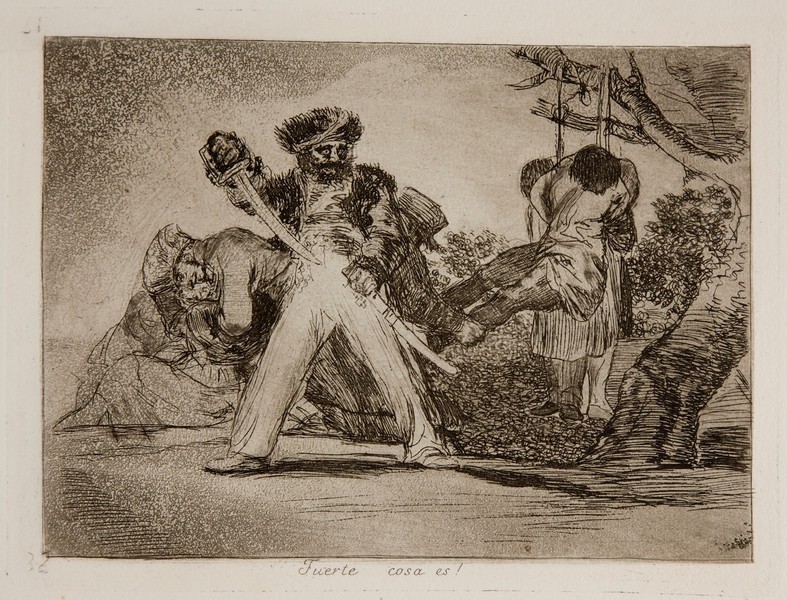- Cronología
- Ca. 1812 - 1815
- Dimensiones
- 155 x 208 mm
- Técnica y soporte
- Etching, burnished aquatint and drypoint
- Reconocimiento de la autoría de Goya
- Undisputed work
- Ficha: realización/revisión
- 08 Dec 2010 / 02 Jun 2023
- Inventario
- 225
32 (on the lower left-hand corner)
See Sad presentiments of what must come to pass (Tristes presentimientos de lo que ha de acontecer).
The number 32 appears on the lower left-hand corner of the third artist's proof.
The title was handwritten on the print by Goya in the first and only series that is known to have been printed at the time the works were created, which the artist gave to his friend Agustín Ceán Bermúdez. Therefore, the title was etched into the plate at a later date and left unchanged as of the first edition of the Disasters of War printed by the San Fernando Royal Academy of Fine Arts in Madrid in 1863, after the printing of the series in the possession of Ceán Bermúdez.
There are no surviving preparatory drawings for this print.
In the centre of the composition a French soldier is holding a sword as he gazes fearlessly at the bodies of two hanged men. Behind that soldier is another who is pulling on the leg of one of the bodies.
Although it is not entirely clear what the French soldiers are doing, it seems that the soldier who is pulling on the hanged man's leg is attempting to check whether he is dead or perhaps to hasten the man's death, increasing the cruelty of the act committed and highlighting the cold-bloodedness of the soldiers carrying out the hangings. The Frenchman in the foreground in the centre of the composition is drawing his sword to cut the rope from which the dead man hangs.
Interpreting the two figures on the left in the background is a more difficult task. A soldier holds up a woman who is partially hidden from view, and it is difficult to tell if the soldier is holding her back, preventing a violent reaction or comforting her in her anguish.
Nature has an important role in this work. As in the case of other prints in the series, the setting is arid, jagged, serving as a weapon capable of inflicting pain on the human body. Nothing in the natural world presented in this work suggests that it is a source of life.
This print is characterized by a somewhat more hasty technique than others in the series, rendered in quicker, more immediate lines. The artist is less precise here than in the case of other prints in The Disasters of War, employing fewer marks to convey figures which are less well characterized.
The plate is stored in the National Chalcography (cat. 282).
-
Goya and his timesThe Royal Academy of ArtsLondon1963cat. 66cat. 242
-
De grafiek van GoyaRijksmuseum RijksprentenkabinetAmsterdam1970from November 13th 1970 to January 17th 1971cat. 73
-
Francisco de Goya: Maleri, Tegning, GrafikkNasjonalgallerietOslo1996from 10th to April 14th 1996cat. 137
-
Francisco de GoyaMuseo d'Arte ModernaLugano1996exhibition celebrated from September 22nd to November 17th.cat. 31
-
Francisco Goya. Sein leben im spiegel der graphik. Fuendetodos 1746-1828 Bordeaux. 1746-1996Galerie KornfeldBern1996from November 21st 1996 to January 1997cat. 117
-
Ydioma universal: Goya en la Biblioteca NacionalBiblioteca NacionalMadrid1996from September 19th to December 15th 1996cat. 225
-
Francisco Goya. Capricci, follie e disastri della guerraSan Donato Milanese2000Opere grafiche della Fondazione Antonio Mazzottacat. 111
-
Goya. Opera graficaPinacoteca del Castello di San GiorgioLegnano2006exhibition celebrated from December 16th 2006 to April 1st 2007p. 66
-
Goya et la modernitéPinacothèque de ParisParís2013from October 11st 2013 to March 16th 2014cat. 70
-
Goya, grabadorMadridBlass S.A.1918cat. 133
-
Goya engravings and lithographs, vol. I y II.OxfordBruno Cassirer1964cat. 151
-
Vie et ouvre de Francisco de GoyaParísOffice du livre1970cat. 1046
-
Catálogo de las estampas de Goya en la Biblioteca NacionalMadridMinisterio de Educación y Cultura, Biblioteca Nacional1996cat. 235
-
ParísPinacoteca de París2013p. 135
-
Goya. In the Norton Simon MuseumPasadenaNorton Simon Museum2016pp. 114-151
